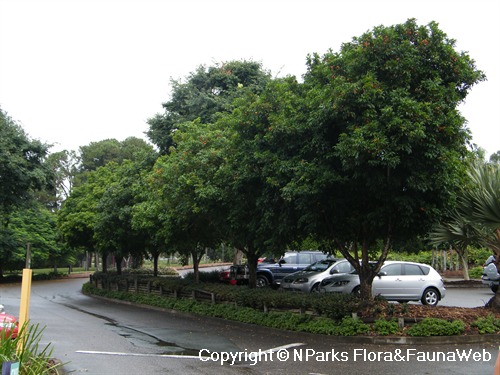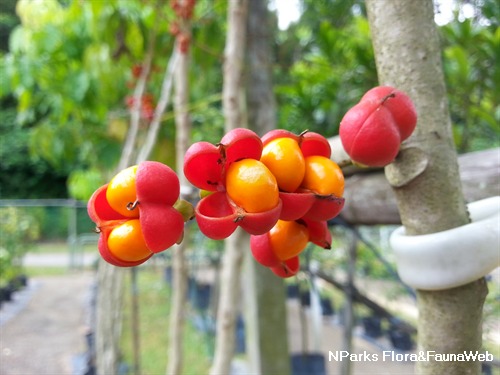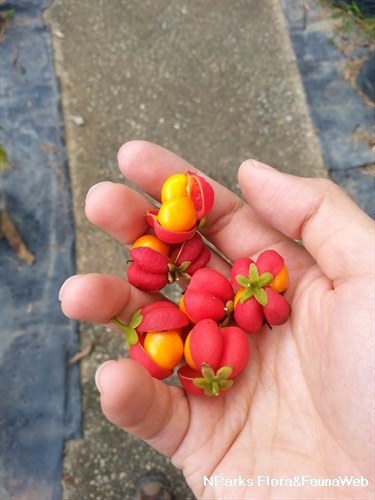
Back
Harpullia ramiflora Radlk.
| Family Name: | Sapindaceae |
| Common Name: | Claudie Tulipwood, Tulipwood, Cape York Tulipwood |
Name
Classifications and Characteristics
| Plant Division | Angiosperms (Flowering Seed Plants) |
|---|---|
| Plant Growth Form | Tree, Shrub |
| Lifespan (in Singapore) | Perennial |
| Mode of Nutrition | Autotrophic |
| Plant Shape | Umbrella |
| Maximum Height | 15 m |
Biogeography
| Native Distribution | Philippines, Moluccas, New Guinea and Australia. |
|---|---|
| Native Habitat | Terrestrial |
| Preferred Climate Zone | Tropical |
| Local Conservation Status | Non-native (Horticultural / Cultivated Only) |
Description and Ethnobotany
| Growth Form | It is a bushy to sparsely-branched shrub or tree, up to 15m tall. |
|---|---|
| Foliage | Its alternately-arranged, stalked, pinnate leaves have 1-7 leaflets. Each leaflet is about 6.5-40 by 2.5-8.5 cm long, ovate to elliptic. |
| Flowers | Its white to creamy, fragrant flowers are borne on stalked, axillary inflorescences that are 1-40 cm long. The inflorescences become ramiflorous or cauliflorous after the leaf drops. |
| Fruit | Its bilobed, capsular fruits are about 1.2-1.8 cm long, ripening bright red in colour, and splitting open. Each black, shiny seed is covered by a bright orange aril. |
| Habitat | It grows in the undergrowth of primary to young secondary forests, coastal forests, freshwater swamp forests, and beside rivers. |
| Associated Fauna | Its seeds are probably dispersed by birds. |
| Cultivation | It can be propagated by seeds. |
| Etymology | Latin Harpullia, from a Bengali common name; Latin ramiflora, flowers from branches, referring to the position of flowers on the plant. |
Landscaping Features
| Landscaping | It is suitable for parks and streetscapes for its attractive bright red fruits. It can also be planted in waterlogged soils. |
|---|---|
| Desirable Plant Features | Ornamental Fruits, Fragrant (Flowers) |
| Landscape Uses | General, Suitable for Roadsides, Parks & Gardens |
Fauna, Pollination and Dispersal
| Pollination Method(s) | Biotic (Fauna) |
|---|---|
| Seed or Spore Dispersal | Biotic (Fauna) |
Plant Care and Propagation
| Light Preference | Full Sun, Semi-Shade |
|---|---|
| Water Preference | Lots of Water, Moderate Water |
| Plant Growth Rate | Moderate |
| Rootzone Tolerance | Moist Soils, Waterlogged Soils (Drains Site) |
| Maintenance Requirements | Moderate |
| Propagation Method | Seed |
Foliar
| Foliage Retention | Evergreen |
|---|---|
| Mature Foliage Colour(s) | Green |
| Mature Foliage Texture(s) | Leathery |
| Foliar Type | Compound (Odd-Pinnate) |
| Foliar Arrangement Along Stem | Alternate |
| Foliar Attachment to Stem | Petiolate |
| Foliar Shape(s) | Non-Palm Foliage (Ovate, Elliptical) |
| Foliar Venation | Pinnate / Net |
| Foliar Margin | Entire |
Floral (Angiosperm)
| Flower & Plant Sexuality | Bisexual Flowers |
| Flower Colour(s) | Cream / Off-White, White |
|---|---|
| Flower Grouping | Cluster / Inflorescence |
| Flower Location | Axillary |
| Flower Symmetry | Radial |
Fruit, Seed and Spore
| Mature Fruit Colour(s) | Red |
|---|---|
| Mature Fruit Texture(s) | Velvety / Furry / Tomentose |
| Fruit Classification | Simple Fruit |
| Fruit Type | |
| Mature Seed Colour(s) | Black |
| Mature Seed Texture(s) | Glossy / Shiny |
| Seed Description | Covered with bright orange aril. |
Image Repository
Others
| Master ID | 29393 |
|---|---|
| Species ID | 3702 |
| Flora Disclaimer | The information in this website has been compiled from reliable sources, such as reference works on medicinal plants. It is not a substitute for medical advice or treatment and NParks does not purport to provide any medical advice. Readers should always consult his/her physician before using or consuming a plant for medicinal purposes. |



